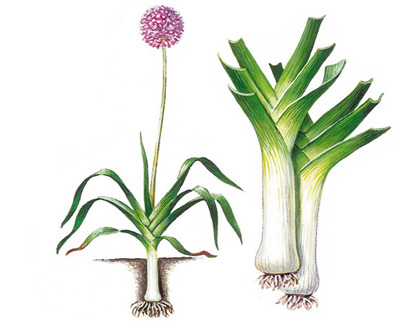Leek
Leek
Allium porrum L.
Amaryllidaceae Family
Description of Leek
Leek is a biennial herbaceous plant 40–120 cm tall, cultivated as an annual. Forms a false stem ("stalk"), cylindrical, 10–30 cm long, 2–5 cm in diameter, without daughter bulbs. Leaves sheathing, linear-lanceolate, flat, 20–60 cm long, 2–5 cm wide, fan-like, green or greenish-blue, with waxy coating, folded along central vein, keeled outside. Flower stalk (in 2nd year) 1.2–1.5 m tall. Flowers gathered in spherical umbel (5–10 cm), white, pinkish or lilac, with rough petals; stamen filaments longer than perianth; cover with long beak. Fruit three-sided capsule with 2–6 black, oval-wrinkled seeds. Flowering in June–July, fruiting in August–September. Propagated by seeds. Varieties: ‘Karantan’, ‘Goliath’, ‘Elephant’.
Distribution and Ecology of Leek
Leek originates from the Mediterranean and Central Asia. Not found in the wild, widely cultivated in Europe, Asia, North America. Prefers loose, fertile soils (pH 6.0–7.0), moderate watering, temperature 15–25 °C, withstands frosts to -7 °C (winter varieties). Grown summer (harvest in July–August) and winter (harvest in September–October) varieties. Propagated by seeds (sow in March–April, no stratification required). Yield: 2–4 kg/m². Care: watering (5–10 L/m² every 7 days), nitrogen feeding (20–30 g/m²), loosening, protection from onion fly and powdery mildew. Grown in open ground or greenhouses. Ecologically improves soil structure, but attracts pests, requiring crop rotation.
Raw Materials from Leek
Raw materials: false stem ("stalk") and leaves (folia et caulis Allii porri). Harvested in July–October (summer varieties 90–120 days after sowing, winter 150–180 days). False stem cut at base, leaves young, up to 30 cm long. Dried at 30–40 °C in shade (yield 10–15%). Quality: stem white or greenish, spot-free; leaves green, moisture <10%. Store fresh in refrigerator (0–5 °C, 1–2 months) or dried in airtight containers (6–12 months). Aroma weakly pungent, onion-like. Gains bitterness in long storage when picked.
Chemical Composition of Leek
False stem: ascorbic acid (13–23 mg%), proteins (1.5–3%), sugars (up to 7%), potassium (250 mg%), calcium, phosphorus, magnesium, iron (0.8 mg%). Leaves: ascorbic acid (30–75 mg%), carotene (5 mg%), vitamins (B1 0.1 mg%, B2 0.04 mg%, E 0.9 mg%), nicotinic acid (0.5 mg%), essential oil (0.1%, disulfides, polysulfides). Calorie content: 35–40 kcal/100 g.
Effects and Applications of Leek
Potassium provides diuretic effect, sulfur-containing compounds (disulfides, polysulfides) have anti-sclerotic and blood-purifying properties. Leek increases appetite, salivation, improves digestion, regulates intestinal function, supports liver and biliary tract. Used for urolithiasis, obesity, gout, rheumatism, scurvy, physical and mental fatigue. Juice used for colds, throat inflammation, rinses for pharyngitis.
Precautions for Using Leek
Raw leek (>100 g/day) may cause stomach irritation or flatulence due to sulfur compounds. Heat treatment reduces risk. Juice (>50 ml/day) irritates mucous membranes in colds. Prolonged consumption (more than 2 weeks) may disrupt intestinal microflora. Store raw materials at humidity <10% to prevent spoilage. Give children under 3 years in doses ≤20 g/day. Do not combine with diuretics without doctor's consultation.
Contraindications for Using Leek
Raw leek contraindicated in peptic ulcer, gastritis with high acidity, pancreatitis, allergy to Allium, children under 1 year. Not recommended in exacerbation of chronic enterocolitis or cholecystitis.
Recipes with Leek
- Juice for Urolithiasis. Grind 100 g false stem, squeeze juice, drink 20 ml 2 times a day, 10 days.
- Infusion for Gout. Pour 50 g leaves with 200 ml boiling water, infuse 1 h, drink 50 ml 3 times a day, 7 days.
- Decoction for Cold. Boil 50 g false stem in 300 ml water 10 min, drink 100 ml 2 times a day, 5 days.
- Mixture for Fatigue. 50 g leek, 20 g honey, mix, eat 1 time a day, 14 days.
- Infusion for Digestion. Pour 30 g ground false stem with 200 ml boiling water, infuse 30 min, drink 70 ml 3 times a day, 7 days.
- Juice for Immunity. Mix 30 ml leek juice with 10 ml honey, take 2 times a day, 10 days.
Cosmetics from Leek
Leek juice used in cosmetology due to antiseptic and nourishing properties of sulfur compounds and vitamin C.
- Face Mask. Mix 20 ml leek juice with 10 g honey, apply to face for 10 min, rinse. Use 1 time a week.
- Lotion for Oily Skin. 20 ml juice, 50 ml water, 5 ml 40% ethanol, wipe face daily.
- Hair Mask. Rub 30 ml juice into scalp, leave 15 min, rinse. Use 2 times a week.
- Body Scrub. Mix 20 g ground leek with 20 g sea salt, massage skin 5 min, rinse. Use 1 time a week.
Culinary Uses of Leek
Leek has mild, weakly pungent taste, finer than onion, gives dishes unique aroma. Richer in sugars, ascorbic acid, potassium than onion. Used fresh, stewed, boiled, canned or dried in salads, soups, side dishes, pastes, preserves. Suits meat (pork loin, lamb), fish dishes, crabs, omelets, fried in batter or breadcrumbs like asparagus.
- Soup with Leek. 100 g false stem, 200 g potatoes, 1 L broth, cook 20 min, serve with herbs.
- Salad with Leek. 50 g leek, 100 g tomatoes, 20 ml oil, mix, season with salt.
- Stewed Leek. Stew 100 g leek with 20 ml oil 10 min, serve as side dish.
- Leek in Batter. Dip 100 g false stem in batter (50 g flour, 50 ml water), fry 5 min.
Tips: Use young stems for soft taste. Store fresh leek at 0–5 °C up to 2 months; dried in airtight jars up to 1 year. Avoid long storage when picked due to bitterness.
Other Properties of Leek
Leek used in landscaping for bed decoration. Juice repels insects (e.g., aphids). Plant improves soil structure, but requires crop rotation to prevent pest accumulation.




